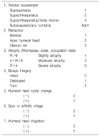Abstract
Purpose
We evaluated the functional outcomes after arthroscopic repair of a massive tear between the tendon to tendon (TT) repair technique and the tendon to tendon and bone to tendon (TTBT) repair technique.
Materials and Methods
From March, 2002 to January, 2007, 43 cases of arthroscopic massive rotator cuff repair were evaluated. 12 were repaired by TT repair and 31 were repaired by TTBT repair. At 1year follow-up, the functional results were assessed by the KSS, ASES, UCLA and Constant scoring system and the P-VAS (Pain visual analogue score). Post-operative integrity was evaluated by an ultrasound examination 6 months after the operation.
Results
In TTBT repair group, the improvement of the KSS, ASES, UCLA and Constant scores were 15.4 (50.5 to 65.9), 28 (55.6 to 83.6), 9.6 (21.1 to 30.7) and 11 (40.7 to 51.7), respectively. The pain improvement was 2.7 (VAS, 3.8 to 1.1) and the retear rate was 62%. In the TT repair group, the functional improvements were 29.2 (33.7 to 62.9), 42.7 (38.6 to 81.3), 13.4 (16.4 to 29.8) and 19.7 (29.6 to 49.3), respectively. The pain improvement was 4.2 (VAS, 5.5 to 1.3) and the retear rate was 75%.
Figures and Tables
 | Fig. 1Post-operative findings after arthroscopic massive rotator cuff repair. (A) Tight repair without gap formation after tendon to tendon and bone to tendon repair. (B) Margin convergence technique with partial tendon to tendon repair which remains gap at the glenohumeral insertion portion. |
 | Fig. 2Supraspinatus long axis view in ultrasonographic evaluation for massive tear. (A) Preoperative USG reveals rotator cuff massive tear. (B) Postoperative 6 months follow up USG of tendon to tendon repair revealed reteared rotator cuff. (C) Preoperative USG reveals rotator cuff massive tear. (D) Postoperative 6 months follow up USG of tendon to tendon repair revealed remained gap. Arrow in figure A, B, C: stump of rotator cuff tear. Arrow in figure D: remained gap. |
 | Fig. 3Functional evaluation after rotator cuff repair. (A) Korean shoulder society (KSS) scoring system. (B) American Shoulder and Elbow Society (ASES) scoring system. (C) University of California Los Angeles (UCLA) scoring system. (D) Constant scoring system. TT: tendon to tendon repair, TTBT: tendon to tendon repair and bone to tendon repair. |
References
1. Burkhart SS. The deadman theory of suture anchors: observations along a south Texas fence line. Arthroscopy. 1995. 11:119–123.

2. Burkhart SS, Danaceau SM, Pearce CE Jr. Arthroscopic rotator cuff repair: Analysis of results by tear size and by repair technique-Margine convergence versus Direct tendon-to-bone repair. Arthroscopy. 2001. 17:905–912.
3. Davidson JF, Burkhart SS, Richards DP, Campbell SE. Use of preoperative magnetic resonance imaging to predict rotator cuff tear pattern and method of repair. Arthroscopy. 2005. 21:1428.
4. DeOrio JK, Cofield RH. Results of a second attempt at surgical repair of a failed initial rotator-cuff repair. J Bone Joint Surg Am. 1984. 66:563–567.

5. Flurin PH, Landreau P, Gregory T, et al. Cuff integrity after Arthroscopic rotator cuff repair: correlation with clinical results in 576 cases. Arthroscopy. 2007. 23:340–346.

6. Gerber C, Fuchs B, Hodler J. The results of massive tears of the rotator cuff. J Bone Joint Surg Am. 2000. 82:505–515.
7. Goutallier D, Postel JM, Lavau L, Bernageau J. Influence of muscular degeneration of the supra- and infra-spinatus on the prognosis of surgical repair of the rotator cuff. Acta Orthop Belg. 1998. 64:42–45.
8. Goutallier D, Postel JM, VanDriessche S, Godefroy D, Radier C. Tension-free repairs with excision of macroscopic tendon lesions and muscularadvancement: Results in a prospective series with limited fatty muscular degeneration. J Shoulder Elbow Surg. 2006. 15:164–172.
9. Harryman DT 2nd, Mack LA, Wang KY, Jackins SE, Richardson ML, Matsen FA 3rd. Repairs of the rotator cuff. Correlation of functional results with integrity of the cuff. J Bone Joint Surg Am. 1991. 73:982–989.

10. Ide J, Maeda S, Takagi K. A Comparison of arthroscopic and open rotator cuff repair. Arthroscopy. 2005. 21:1090–1098.

11. Jones CK, Savoie FH 3rd. Arthroscopic repair of large and massive rotator cuff tears. Arthroscopy. 2003. 19:564–571.

12. Jost B, Pfirrmann CW, Gerber C, Switzerland Z. Clinical outcome after structural failure of rotator cuff repairs. J Bone Joint Surg Am. 2000. 82:304–314.

13. Lafosse L, Brozska R, Toussaint B, Gobezie R. The outcome and structural integrity of arthroscopic rotator cuff repair with use of the double-row suture anchor technique. J Bone Joint Surg Am. 2007. 89:1533–1541.

14. Liu SH, Baker CL. Arthroscopically assisted rotator cuff repair: correlation of functional results with integrity of the cuff. Arthroscopy. 1994. 10:54–60.

15. Lo IK, Burkhart SS. Arthroscopic repair of massive, contracted, immobile rotator cuff tears using single and double interval slides: technique and preliminary results. Arthroscopy. 2004. 20:22–33.

16. Musil D, Sadovský P. Massive tears of the rotator cuff-comparison of mini-open and arthroscopic techniques. Part 2. Arthroscopic repair. Acta chir Orthop Traumatol Cech. 2007. 74:318–325.
17. Rebuzzi E, Coletti N, Schiavetti S, Giusto F. Arthroscopic rotator cuff repair in patients older than 60 years. Arthroscopy. 2005. 21:48–54.

18. Sugaya H, Maeda K, Matsuki K, Moriishi J. Repair integrity and functional outcome after arthroscopic double-row rotator cuff repair. A prospective outcome study. J Bone Joint Surg Am. 2007. 89:953–960.
19. Sugihara T, Nakagawa T, Tsuchiya M, Ishizuki M. Prediction of primary reparability of massive tears of the rotator cuff on preoperative magnetic resonance imaging. J Shoulder Elbow Surg. 2003. 12:222–225.





 PDF
PDF ePub
ePub Citation
Citation Print
Print





 XML Download
XML Download